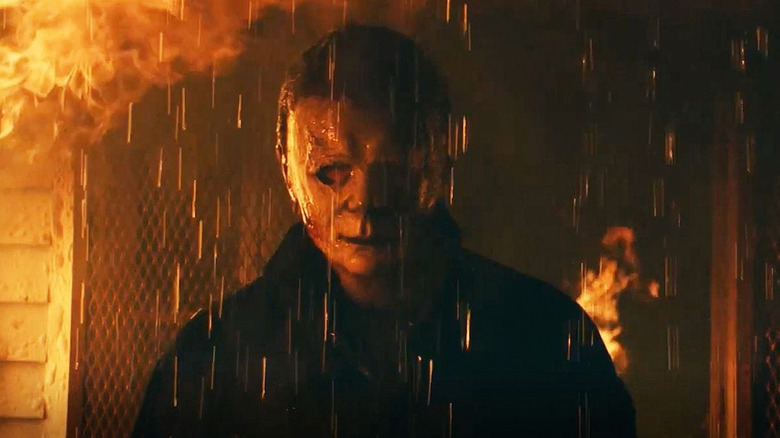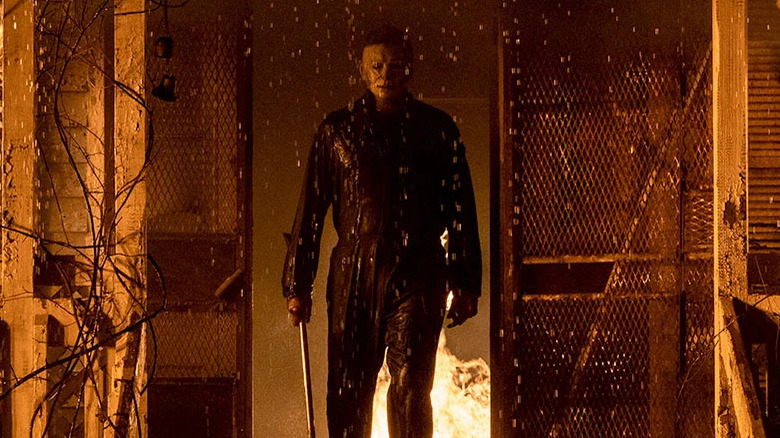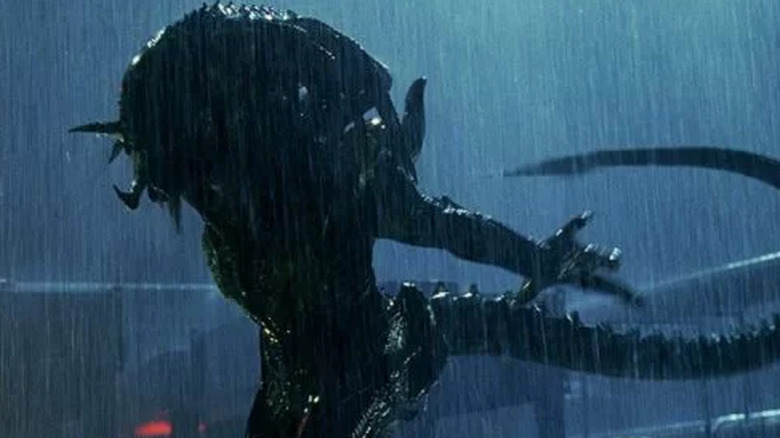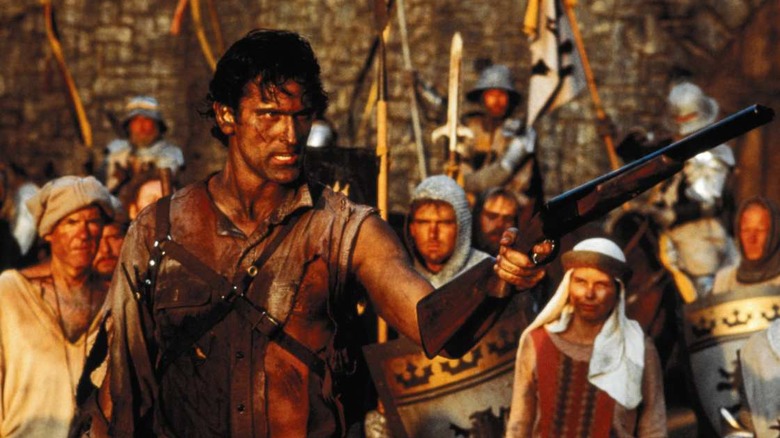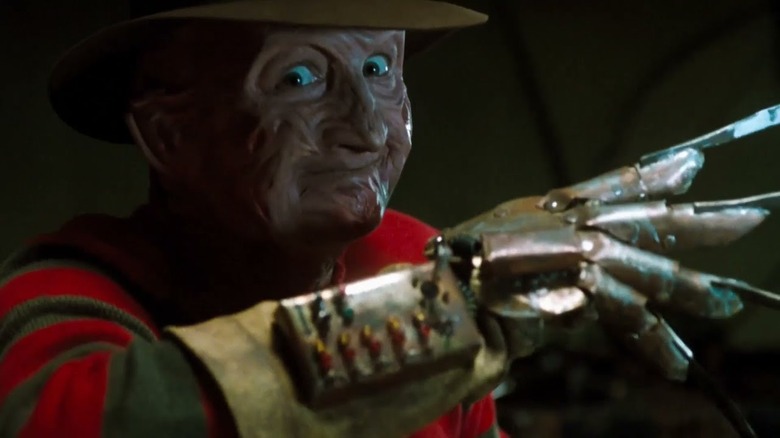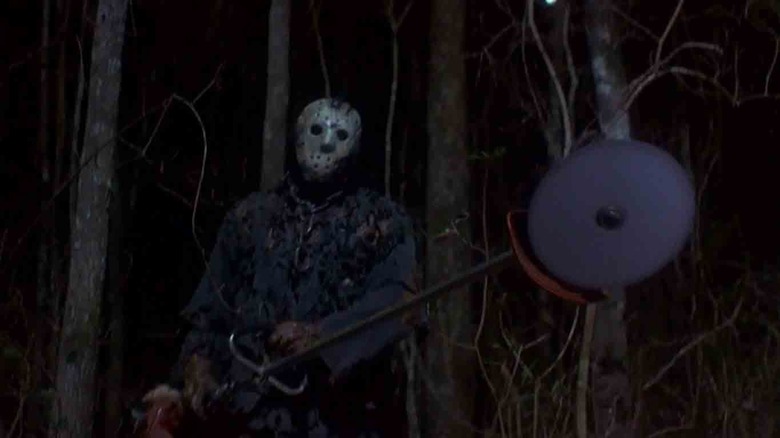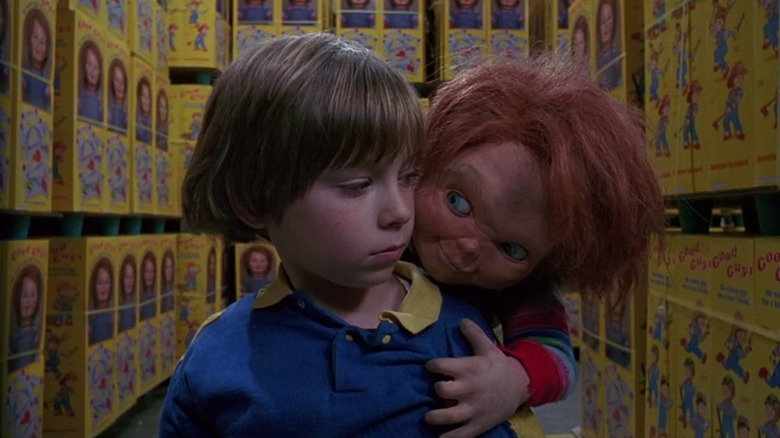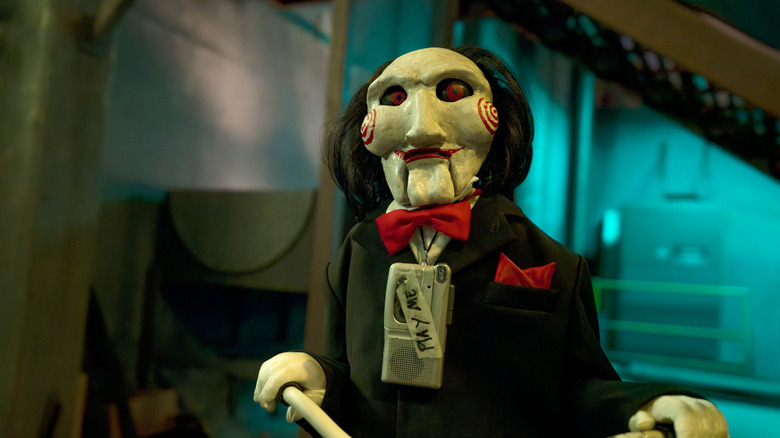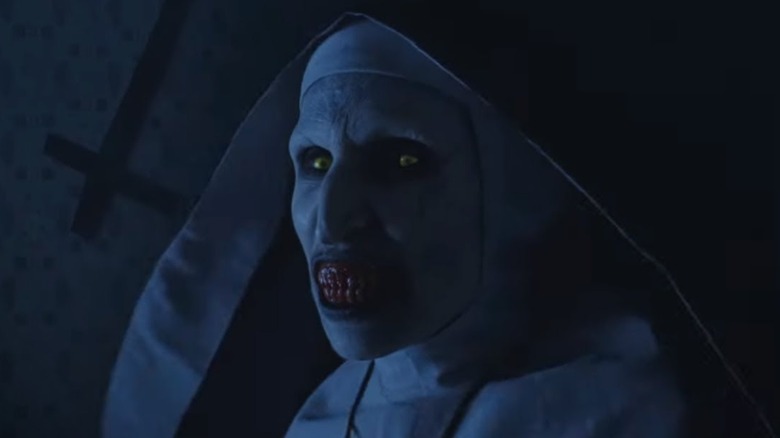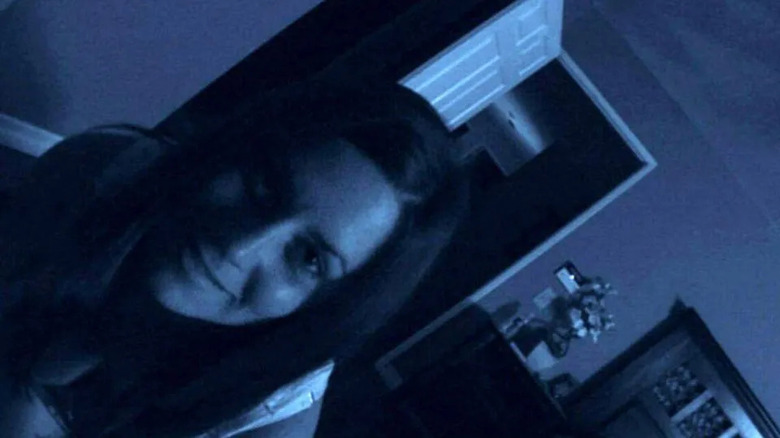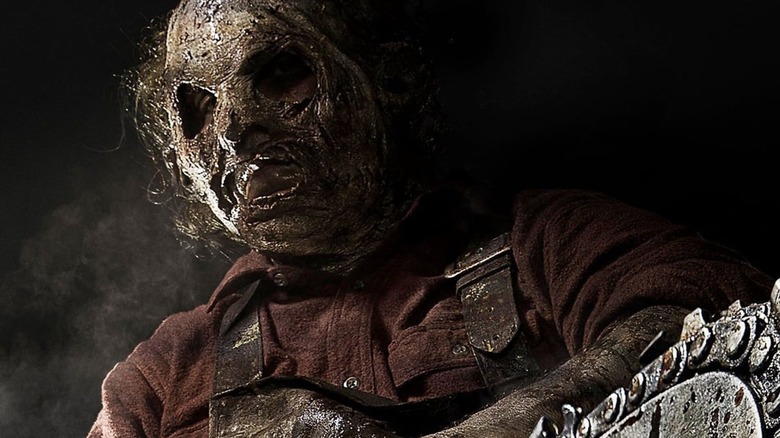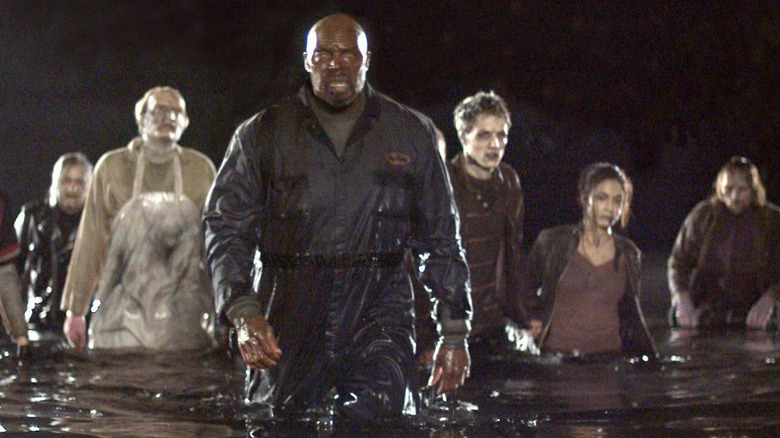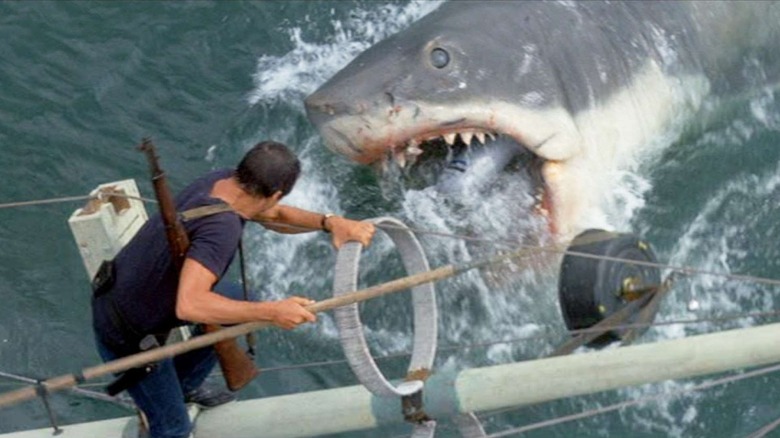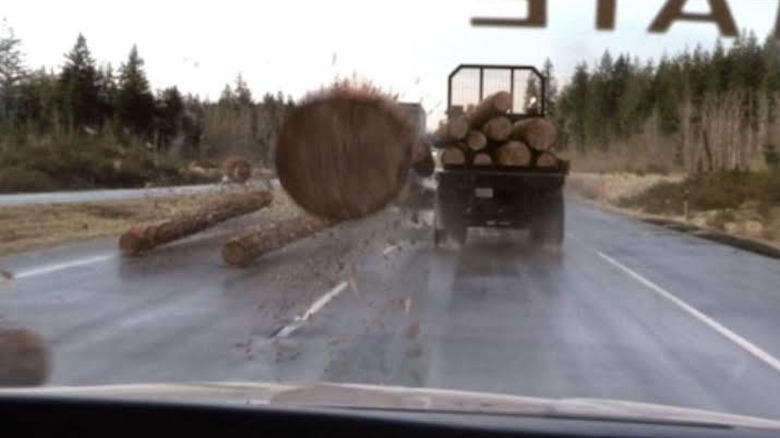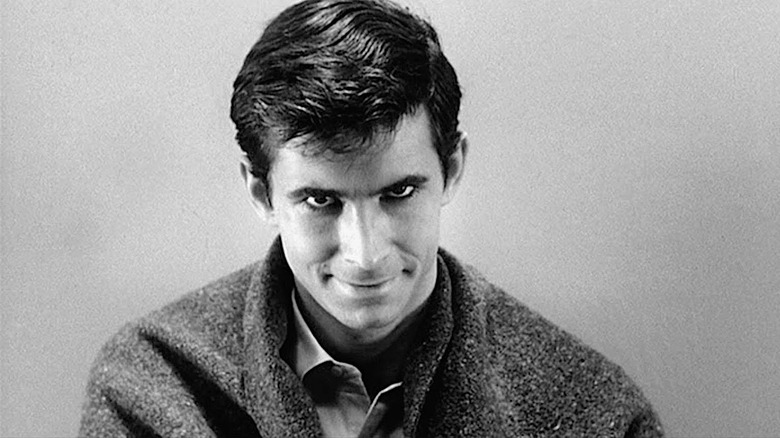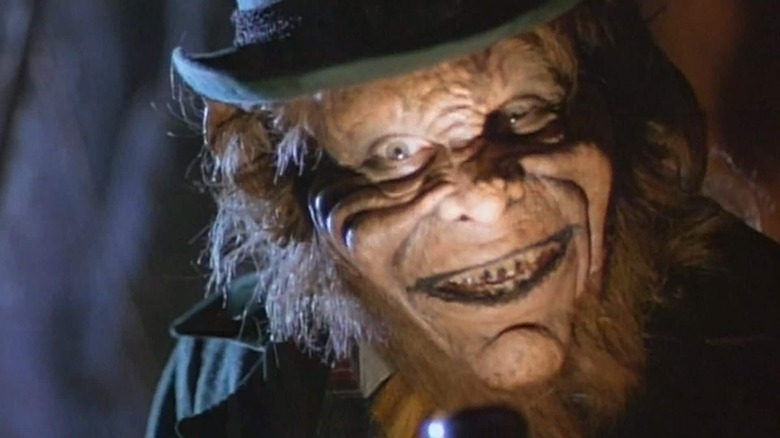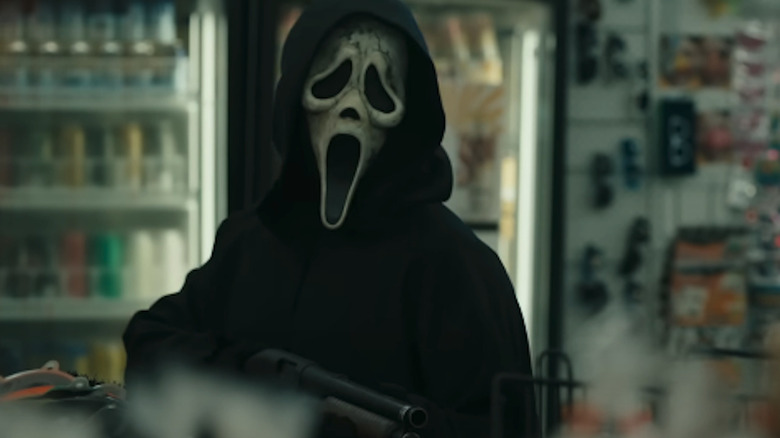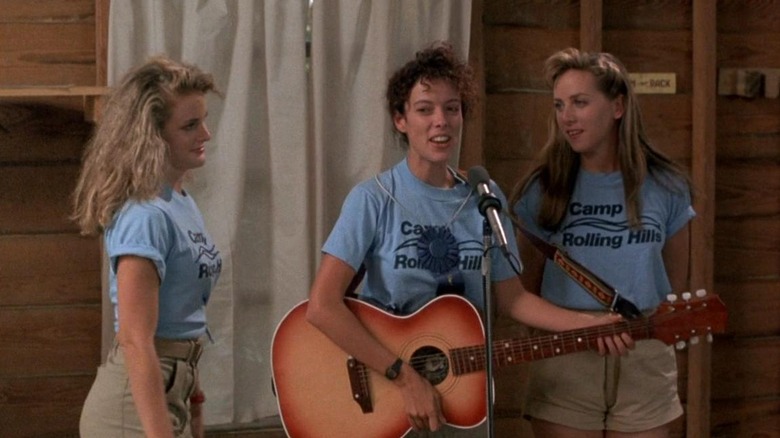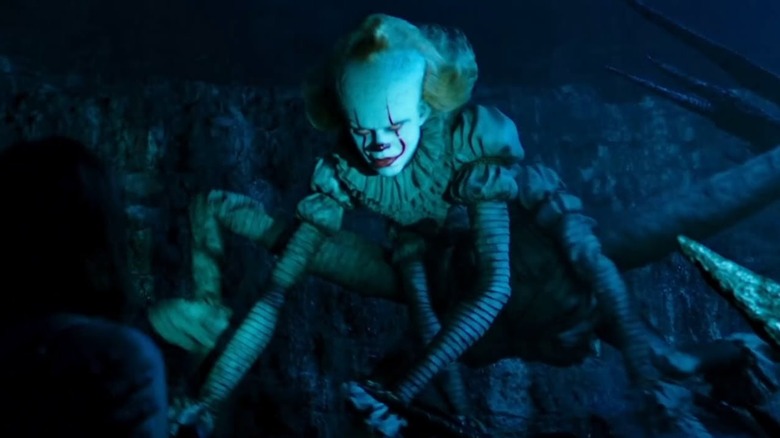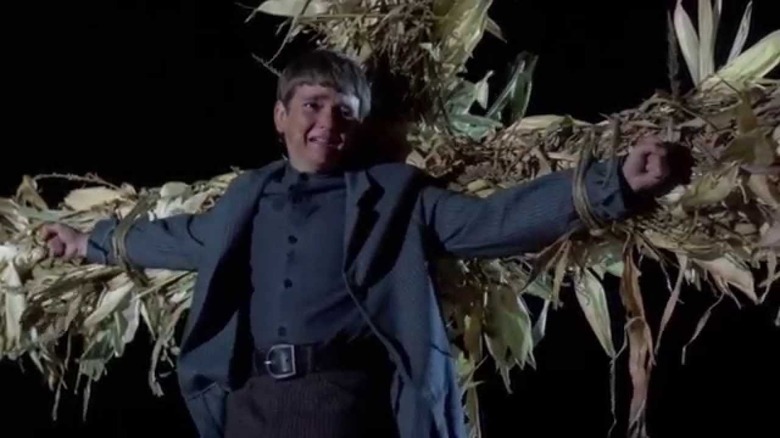19 Horror Franchises That Completely Jumped The Shark
The Cambridge Dictionary defines jumping the shark as reaching a point where something stops becoming more popular or starts to decrease in quality. This term was coined after a now-infamous episode of "Happy Days," where the Fonz literally jumped a shark while jet skiing. But jumping the shark can also mean when a franchise has gone so far from what's expected of it that the movies are no longer recognizable. This can also be applied to series that have long stopped taking themselves seriously and opt to revel in their own absurdity. Nowhere is this more applicable than in the horror genre, where absurdity and excess are served for breakfast.
Horror has proven itself to be a very lucrative genre, a perfect breeding ground for sequels of all shapes and sizes. However, jumping the shark, as we've established, can mean a few different things depending on the context. Is the series still good but it simply embraced its own ridiculousness or has the overall quality long since bottomed out? So grab your machete and keep watching the skies, because these horror franchises have completely jumped the shark.
Halloween
For a series with unbelievably humble roots, the "Halloween" films have certainly gone to the moon and back with their absurdity. When first conceived by director John Carpenter back in the 70s, "Halloween" was about as bare bones as a horror film could get. Made for only $325,000 — a comparatively low budget at the time — the film terrified audiences with riveting suspense and expertly crafted atmosphere.
Subtlety was the main crux of the film's success — quite ironic, considering the tonal left turn the series was about to take. In "Halloween 2," final girl Laurie Strode is revealed to be Michael Myers' sister, a decision Carpenter blames on too much drinking. Following an experimental anthology entry with "Halloween 3: Season of the Witch," the series would double down on the Michael Myers formula. With each subsequent sequel Myers' ability to sustain punishment became more and more absurd, bordering on "Looney Tunes" territory at times. This includes Myers' being revealed as a member of a thorn-based cult and even getting karate kicked by Busta Rhymes.
This isn't even counting the Rob Zombie remake duology or David Gordon Green's revival trilogy, both of which boast their own hysterical highlights. From Michael butchering a fleet of firemen to a bratty child taking a swan dive down a stairwell, we are as far removed from the original's minimalism as possible.
Alien
When it comes to film series that have long since gone off of the rails, look no further than "Alien." The 1979 original, directed by Ridley Scott, is a film that's as fascinating as it is terrifying, taking full advantage of its isolating deep space setting. This first film is what introduced the threat of the Xenomorph, a sinister alien being with acid for blood. In "Aliens," the James Cameron-helmed sequel, the series went in a more action-oriented direction as the Xenomorph threat grew in numbers. However, as the series progressed, various directors chose to take the Xenomorphs in some rather peculiar directions. In "Alien 3," we'd be treated to a Xenomorph-dog hybrid that ran on all fours, resulting in a rather ridiculous visual. There was also "Alien Resurrection" which contained a Xenomorph-human hybrid, complete with big soulful eyes and pale skin.
Things got even funnier when the Xenomorphs ended up squaring off with the Predators in the "Alien vs. Predator" movies. This combo even resulted in an absurd-looking Alien-Predator hybrid known as the Predalien, a Xenomorph with Predator-like dreadlocks. Even both "Prometheus" and "Alien: Covenant," though well-made, still took the series in questionable directions. When your franchise shifts from acid bleeding aliens to a robotic Michael Fassbender as its main threat, it's safe to say you've jumped the shark. Depending on whom you ask, "Alien: Romulus" may not have righted the ship.
Evil Dead
The "Evil Dead" movies have completely jumped the shark but don't misunderstand: that's exactly why fans love them. In terms of sheer excess, no horror franchise has gone to hell and back quite like the brainchild of Sam Raimi. Even the original film, with its almost comically small budget, still took that money and stretched it as far as it could go.
What emerged from Raimi's shoestring efforts was the beginnings of the Deadites, a horde of sadistic and mentally manipulative demons. We'd also meet series protagonist Ash Williams (Bruce Campbell), a hardware store employee who tampers with the Book of the Dead while on a weekend getaway with his girlfriend. From there, every subsequent film would expand on the ancient lore of the evil book, as well as turn Ash into more of an action hero.
By the time "Army of Darkness" comes around, Ash travels back to Medieval times, builds a mechanic arm, and even defeats a Deadite army. This isn't even touching the more modern reimaginings directed by the likes of Fede Álvarez's 2013 "Evil Dead" and Lee Cronin's "Evil Dead Rise" from 2023. Throw in the short-lived "Ash Vs. Evil Dead" television series and you have a franchise that stopped playing by the rules a long time ago. With the series far from over, we can only assume there is more high-octane gore and splatter-soak slapstick in our future.
A Nightmare on Elm Street
The roots of the "Nightmare on Elm Street" movies actually begin within the pages of the Los Angeles Times. Director Wes Craven was severely disturbed by the tales of Cambodian refugees all dying in their sleep, which inspired the genesis of Freddy Krueger (Robert Englund). From this concept arose a disturbing premise regarding a burned man, with knife-adorned fingers, stalking teens in their dreams.
It was a far more fantastical concept than the slasher genre had seen up until that point and, judging by the film's box office gross, certainly turned some heads. Suddenly, the once-struggling New Line Cinema suddenly had a viable property on their hands, meaning that Freddy was quickly greenlit for a sequel. However, with every passing sequel, especially with the reduced involvement of Craven, the series went in some truly gonzo directions. This includes Freddy possessing someone's body, turning a weightlifter into a cockroach and even using a knock-off Nintendo Power Glove as a killing apparatus.
The vibe of the series as well became increasingly comical in each subsequent sequel, with Freddy spouting a torrential downpour of one-liners. Now even though most of the sequels are still enjoyed immensely by many horror fans, there's no denying the significant shift in tone and presentation. If Freddy morphing into a comic book supervillain or dressing up as the Wicked Witch isn't jumping the shark, then we don't know what is.
Friday the 13th
"Friday the 13th," the series that made the prospect of a weekend in the woods a significantly more terrifying one. When Sean S. Cunningham penned the first theatrical outing to the now-iconic Camp Crystal Lake, it's very unlikely he could've predicted its success. After all, the first film is a supremely far cry from the rest of the years, far more barebones. Jason Voorhees, the hockey mask and machete-wielding icon of the series, wasn't even the killer in the first film, but rather his homicidal mommy dearest.
However, after his mommy's beheading, Jason took center stage as the franchise's main antagonist, resulting in several sequels and even a remake. From there, the series became bigger, far more bombastic, and far more bloody with each entry – that is, as much as the MPAA would allow in the 80s.
Jason's range of murderous weaponry evolved to the likes of corkscrews, harpoon guns, weed whackers, and even a party horn. Not only that, but Crystal Lake's favorite son made his way to, not just Manhattan, but to hell itself and even outer space where he's become a cyborg. Time will only tell if Peacock's "Crystal Lake" TV series will be in line with the camp of the films or play things more seriously.
Child's Play
The "Child's Play" series is a prime example of how an already silly idea can be made even more ridiculous as time goes by. In the first film, directed by Tom Holland (no, not that one), we're introduced to Charles Lee Ray aka Chucky (Brad Dourif), the Lakeshore Strangler. Following a police shootout, Ray is fatally wounded and is forced to transfer his soul into a Good Guy doll, a popular children's toy via voodoo magic. The toy in question is soon acquired by six-year-old Andy Barclay who soon becomes Chucky's main target for a brand new body.
As the sequels piled up, Chucky took all kinds of punishment — from being set on fire to being melted with hot plastic to being mulched by an industrial fan. As if things couldn't get any weirder, in "Bride of Chucky" we're introduced to Tiffany Valentine (Jennifer Tilly), Chucky's equally twisted lover. Then, in "Seed of Chucky," we'd meet Chucky and Tiffany's child, a non-binary doll by the names of Glen and Glenda.
In more recent sequels, the absurdity has only increased, especially with the addition of multiple Chucky dolls and voodoo spells. In "Chucky" the television series, we are even treated to not only an army of Chucky clones, but even ones with super strength.
Saw
In the early-2000s, horror started going through some massive changes due in part to one film — James Wan's "Saw." The film sees two seemingly innocent men, Dr. Gordon (Cary Elwes) and Adam (Leigh Whannell), trapped in a grimy bathroom — both shackled to rusty pipes. Soon enough they realize they are now in the middle of a game conducted by a serial killer by the name of Jigsaw (Tobin Bell). We learn that this Jigsaw has been taking people who don't appreciate their lives and forcing them into sadistic games to fight for their survival. This gruesome yet enthralling concept definitely connected with audiences, turning the first "Saw" into a smash hit.
Following the film's hot opening weekend, "Saw 2" was immediately put into production, debuting in theaters just a year later. However, the sequel saw the beginning of a trend that ended up following the series into the modern day — upping the ante in terms of gore and violence. In every subsequent "Saw" sequel, Jigsaw's traps only grew in terms of scale and absurdity, with some making you question their practicality. This included the likes of shotgun merry-go-rounds, a speeding car, and even a trap placed in a public storefront with a crowd watching. Add to that, with every film, the series' already soap opera-tinted story only grew in convoluted twists and reveals.
The Conjuring
Upon its release in 2013, "The Conjuring" was a true return to form for the haunted house genre, aided majorly by James Wan's clever direction. Wan definitely elevated what could've been another dime-a-dozen horror release with legitimate suspense and stellar camera work. The film, loosely based on true events, sees paranormal investigators Ed and Lorraine Warren investigate a haunted house owned by the Perron family.
"The Conjuring" was a big success financially, which naturally warranted a sequel, which was released just 3 years later in 2016. "The Conjuring 2," this time set in England, was also a big success but definitely marked a shift in tone for the series. Compared to the first time around, the scares are much bigger, more bombastic and far more over the top. This is also where "The Conjuring" universe started to become a thing, with Warner Brothers looking to craft a horror version of the Marvel cinematic universe. This meant characters like "Annabelle" and "The Nun," both introduced in the first two films, ended up getting their own spin-off series.
"The Conjuring: The Devil Made Me Do It," released in 2021, was the first film of the main series to not be directed by James Wan. While also a substantial hit at the box office, this entry was far less well-received critically, boasting a narrative more ridiculous than legitimately terrifying.
Paranormal Activity
Horror really seems to be the best genre for the most simplistic, bare-bones ideas to thrive. The first "Paranormal Activity" is still a perfect example of making big bucks with very little in terms of panache. The film is simply a suburban couple, Katie and Micah, being haunted in their home and filming themselves as they sleep to capture any supernatural events. Made independently and for only $15,000 before reshoots, to say the film was profitable for Paramount Pictures would be a gross understatement. Paramount went all in on the series and pumped out six sequels of rapidly diminishing quality over the next decade.
Simply put, the series just became too convoluted and ridiculous for its own good, losing the simplicity that made the first one so captivating. Over the course of the subsequent sequels, we learn that Katie's family has dealings with evil demons who've come to collect in the modern day. In "Paranormal Activity: The Marked Ones" we learn that apparently time travel exists in this world when a character is teleported into the first film's events. We think it's safe to say that when a series begins introducing time travel you can consider the shark fully jumped.
Texas Chainsaw Massacre
You can honestly make a case that the original "Texas Chainsaw Massacre," directed by Tobe Hooper, is one of cinema's scariest movies. From its grainy and grimy cinematography to the depraved performances of the killers, the whole thing oozes this disturbing level of reality. Cinemassacre's James Rolfe put it best when he said, "What makes this film so scary isn't about whether or not it actually happened, but that it could happen." Sadly that same appraisal can't be given to the rest of the "Texas Chainsaw Massacre" movies, all ranging from ridiculous to downright embarrassing.
Long gone are the series' gritty roots and in its place, a siege of over-the-top performances and comically gruesome murders. For starters, there's "Texas Chainsaw Massacre 2" which has Leatherface dry-humping one of his prospective victims with his chainsaw. There was also the fourth film, "Texas Chainsaw Massacre: The Next Generation," a pseudo-parody of the franchise.
By the time the Marcus Nispel-helmed reboot came out in 2003, the series was desperate for a return to form. The remake did help re-inject some much-needed realism back into the series but this quickly ran dry in the follow-up prequel, "The Texas Chainsaw Massacre: The Beginning." Since then it's been a series of increasingly infuriating entities, including "Texas Chainsaw 3D," another prequel in the form of "Leatherface" and Netflix's pseudo-sequel from 2022. Hopefully, at some point, the "Texas Chainsaw Massacre" series will be placed in better hands and restored to its former glory.
George A. Romero's Living Dead series
George A. Romero is a name that will stand the test of time in the annals of horror history. The man helped to revolutionize the genre when he unleashed the original "Night of the Living Dead" in 1968. Something that worked out in the film's favor was that it had premiered just one month before the launch of the MPAA rating system. This meant that it was one of the final horror films of its kind to be seen by kids and teenagers without restriction.
Its success and cultural status led to a sequel a decade later under the title, "Dawn of the Dead." This big-budget sequel was also a hit, leading to the far more gruesome "Day of the Dead" in 1985. Had the series concluded right then and there we likely wouldn't be included here, however, that's sadly not the case.
Romero continued to make sequels, even long after interest in the series had plateaued, the first of which is "Land of the Dead" in 2005. This began a streak of Romero making more modern attempts at social commentary, similar to what he'd done in the original trilogy. However, Romero was already in his 60s by the time the '00s came around, meaning his attempts at being topical came off as extremely antiquated. Despite his legendary status, Romero's "Living Dead" movies are a prime example of knowing to quit when you're ahead.
Jaws
It's the film that made people afraid to go swimming and made Steven Spielberg a household name. Released in 1975, "Jaws" can truly be considered one of the original summer blockbusters, alongside the original "Star Wars." The plot is a simple one: a local police chief named Martin Brody must contend with a great white shark that terrorizes his small seaside town of Amity Island.
What makes "Jaws" so effective is just how effectively it hides the shark for most of the movie, letting the viewer fill in the blanks. In its place are prolonged sections of seeing the shark's point of view underwater or brief glimpses of it as it goes in for the kill. Given the film's tremendous box office run, conversations regarding a sequel quickly began but unfortunately wouldn't involve Spielberg for very long. Per the documentary on the "Jaws 2" DVD, Spielberg turned down the project almost immediately, not wanting to cheapen the success of the first film.
Following his refusal, "Jaws 2," as well as the other sequels, were trusted with comparatively less skilled hands than Spielberg's. This resulted in three increasingly hokey sequels that lack any of the visceral suspense or crisp direction of the original film. By the time "Jaws: The Revenge" came around, the shark looked more and more like a theme park animatronic than a fearsome creature of the deep.
Final Destination
If ever a horror series predicated itself on upping the ante with each subsequent film, it'd definitely be "Final Destination." The plot of the first film, much like all its sequels, follows a pretty simple format: a group of people survives a disaster due to a character's random precognition. So now, having cheated their respective demises, the specter of death itself begins picking people off in their originally intended order. It's a stellar concept and one that the films take full advantage of by running down an impressive laundry list of deaths.
This includes an absolute whammy of a sequence in "Final Destination 2," where massive logs fall off of a flatbed truck and cause a multi-car massacre on the highway! However, as the series went on, the deaths began to resemble Rube Goldberg machines as opposed to Death's sinister machinations. By the time the third, fourth, and fifth films came around, we had people dying via tanning booths, motor speedway accidents, and even eye surgery. With another entry on track for release in the near future, we can only wonder what preposterous methods of murder the series will trot out next.
Psycho
Alfred Hitchcock's "Psycho" is a film that doesn't fully reveal its sinister endgame until its closing scenes. The film sees Marion Crane (Janet Leigh), a woman who, whilst fleeing with $40,000 of her boss' money, winds up at the Bates Motel. It's here she meets Norman Bates (Anthony Perkins), a friendly yet off-putting gentleman who seems to have an unhealthy obsession with his mother. Soon enough, Marion is slain in the shower by someone who, at first, appears to be none other than Norman's mother. However, by the end of the film, it's revealed that Mrs. Bates is long dead and Norman has been masquerading as her in a warped mental state.
The film ends with Norman, fully engrossed by his mother's personality, sitting in holding before he's eventually incarcerated – not much room for a sequel, right? However, in 1981, that's exactly what we got in, the mildly campy but admittedly very entertaining, "Psycho 2." Sadly though, this is where the subsequent movies started getting infinitely goofier — and at breakneck speed to boot! "Psycho 3" basically tried to turn Norman into just another '80s slasher villain, a far cry from the more multilayered character he once was. Add in a horrendous shot-for-shot remake starring Vince Vaughn, plus the lauded "Bates Motel" prequel series, and you have a series just as eclectic as it is ridiculous.
Leprechaun
In fairness, with a concept as thoroughly insane as a gold-obsessed killer leprechaun, jumping the shark is practically unavoidable. To be perfectly clear, none of the "Leprechaun" films really make it into the realm of being good cinema. While they are most certainly enjoyable, let's be honest, the image of Warwick Davis in a creepy green suit is more hilarious than terrifying.
With every sequel, the absurdity of the gimmick was pushed further and further, usually by putting the titular Lubdan The Leprechaun in a new location. This includes the likes of Las Vegas and even space, making him the third famous horror character to leave Earth, right alongside Jason Voorhees and Pinhead. Following those escapades, Lubdan found himself in a more (comparatively) grounded setting when he'd find himself in the hood in two back-to-back sequels.
When your series has gotten to the point where it has a scene in which a Leprechaun is smoking cannabis, then you know you've gone too far. Throw in a rapping sequence and a reboot starring WWE's Hornswoggle and you have a franchise that fully jumped the shark clean into orbit.
Scream
The "Scream" films are a delicious example of how a franchise can embrace its own shark jumping with ample gusto. When Wes Craven unleashed the first "Scream" on the world, he couldn't have predicted that his self-aware slasher movie would spawn five sequels. The first film introduces the town of Woodsboro and high schooler Sidney Prescott, a girl who finds herself caught in a killer's crosshairs. This is where we met Ghostface, a chatty killer who, while donned in a dime-a-dozen Halloween costume, calls his victims before waxing them off.
The first film ends with Sidney discovering the killer, or rather killers, to be her boyfriend Billy and his chucklehead buddy Stu. So where exactly does one go from there? Well, how about absolutely crazy, which is what the series has opted to do with every passing installment. Every "Scream" film makes a bigger and bigger deal out of the mystery of who the killer is, resulting in some seriously weird moves. Not only that but the most recent two films, "Scream 5" and "Scream 6," have introduced some curious new wrinkles. This includes Samantha Carpenter, the previously unknown child of Billy Loomis, who sees bloody visions of her dead father. We can only assume the series will be doubling down on its longstanding absurdity in "Scream 7."
Sleepaway Camp
"Sleepaway Camp" is often looked at as just another one of the various summer camp horror films released in the wake of "Friday the 13th." However, this is doing the film a huge disservice as — some hokey acting aside — the first "Sleepaway Camp" is a legitimately creepy film. A big part of that is due to the legitimately haunting performance of Felissa Rose as Angela Baker, the camper eventually revealed as the killer.
However, what many people might remember most from this film are its final moments where the big twist is revealed. That being Angela actually being revealed to be a boy named Peter, having adopted the identity of his dead sister. The final image of a naked Angela, covered in blood, making animal sounds will always be an all-time horror visual.
Sadly though, this level of quality quickly diminished, with both "Sleepaway Camp 2: Unhappy Campers" and "Sleepaway Camp 3: Teenage Wasteland" becoming far campier affairs. Gone was Rose's legitimately unsettling performance as Angela, as well as the film's legitimately unhinged tone, resulting in far more generic films. There was an attempt to refuel the franchise in 2008 with "Return to Sleepaway Camp," but this also missed the mark, boasting some awful performances and special effects. Despite a very strong start, the "Sleepaway Camp" series leaned into its own absurdity far too quickly, much to its unfortunate detriment.
IT
While we mean no disrespect to Stephen King, it wouldn't be unfair to say that some of his stories fly just a bit too close to the sun. Nowhere is this more evident than in one of his heftier titles both in terms of plot and actual size, the 1000-plus page epic, "IT." The tale of the Loser's Club and Pennywise the Dancing Clown culminates in spectacularly bizarre fashion when the titular monster reveals its true form. The form in question is that of a giant alien spider, a concept that neither the 1990 miniseries nor "It Chapter Two" could effectively convey.
Giant clown spiders aside, "It Chapter Two" is a significant downgrade from the home run that was "It Chapter One." Not only is the tone significantly goofier, but gone is the legitimate suspense of the first film, and in its place, a barrage of hokey jump scares. By this point, it almost seems that any attempt to adapt the latter half of "It" will always result in unintentional onscreen hilarity. Whether it's the B-movie effects of the television series or the comical CGI of the 2019 sequel, it's a moment that always deflates the room. It's a rare example of a horror story that has jumping the shark built into its very DNA.
Children of the Corn
Much like the "Leprechaun" movies, the "Children of the Corn" series didn't exactly start off in a sensible fashion. Based on the Stephen King story of the same name, the film follows a small rural town that's devolved into chaos. Due to the machinations of a sinister boy named Issac, all the town's children have killed all their parents, as well as all the other adults in town. Now they all follow Issac's teachings as they worship a figure known only as He Who Walks Between The Rows.
With a concept like that, you wouldn't think you'd be able to milk many sequels out of it. But somehow, they found a way. Amazingly, there have been a total of nine "Children of the Corn" sequels, with the most recent being released in 2023. The sequels have included some truly preposterous moments, including Isaac being resurrected after being killed off in previous films. There were also the various ways they've reimagined He Who Walks Between The Rows, often turning it into a demonic monster with funny-looking tentacles. This series, much like many other series on this list, started off silly and just proceeded to up the ante as much as possible.
